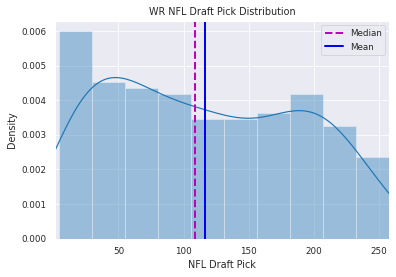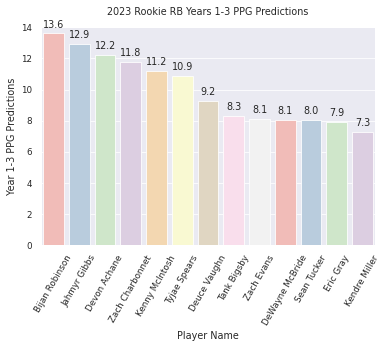Predicting the Fantasy Results of the 2023 RB Class
Last week, I wrote about applying a machine-learning model to the 2023 rookie wide receiver class. Today we turn our attention to the running back position. The goal for both is to project how many fantasy points per game each player will average over their first three seasons in the NFL. From 2015 to 2022, there are 232 running backs whose first NFL season was in this range. This includes both drafted and undrafted players.
These are the players we’ll use to build our model. The benefit of using a machine learning model is that they are uniquely suited to finding complex patterns between variables. A limitation of this approach is that 232 is a very small number of players for a model to learn these patterns on. So, like with any model, we’ll need to provide additional context to its results.
The model uses 24 variables to try to predict future running back fantasy points. They can be split into 4 groups: best season rushing production, best season receiving production, play style, and general. Best season rushing production includes a player’s top performance across their college career in things like rushing attempts per game and rushing touchdowns per attempt.
Best season receiving production is identical but for things like yards per route run and targets per game. Playstyle includes both avoided tackles and explosive runs per attempt, among others. Finally, the general group includes where they were selected in the draft and the number of college games played.
For draft picks, I’m currently using NFL Mock Draft Database’s consensus big board for the 2023 class. As mentioned in last week’s article, draft capital is relatively more important for wide receivers than it is for running backs.
This is because the distributions of draft picks for the two positions are very different. Looking at the two graphs below, wide receivers have been drafted earlier far more often than running backs over the last 8 drafts. While this isn’t a surprise, it indicates that talented running backs are available later in drafts, reducing the predictive ability of draft picks on future fantasy points.


Just like for wide receivers, you’ll notice I don’t have any Combine metrics included. The benefit of excluding them is that we can keep all players that weren’t invited to the combine or didn’t take part in some or all drills in the dataset. The downside is that these variables aren’t helping the model make predictions.
Yet, combine statistics for RBs are much more predictive of their draft selection (something we have already included) than their actual NFL value. The one that has provided the most signal has been the 3-cone drill. Unfortunately, we only saw two running backs perform this drill at the 2023 combine (Evan Hull and SaRodorick Thompson Jr.).
So what variables matter more for future NFL fantasy points? Below are two bar charts that show the model’s gain or relative contribution to the model by variable. A higher number indicates that a variable is more important for prediction. Each position has a very different split, as mentioned with the relative importance of draft capital differing for wide receivers and running backs.


The two variables that provide the model with the largest gain are college rushing yards per attempt and PFF’s rushing grade. No real surprises there as it’s logical that rushing efficiency in college could carry over to the NFL. What is a bit surprising is that the next seven variables until yards after contact per attempt (YCOPA) are all related to the passing game.
Yet, given that a target is worth about 2.5 times the fantasy points as a carry in PPR leagues, a running back’s proven ability to command targets and excel in the passing game is extremely valuable. We’ll see this, especially in the model’s 2023 projections. So, let’s see how the model actually performs. I held last year’s class out of the model-building process to get a sense of how good it is at projecting future fantasy points.

The 2022 class has only had 1 NFL season, but we already have an updated sense of how they’ll perform. Breece Hall and Kenneth Walker both looked spectacular in their first season in the NFL. Having those two backs as a clear first-tier looks great so far. Even if he has averaged 9.4 fantasy points per game in the NFL, the biggest miss so far is Tyler Badie.
Love our content? Check out the GoingFor2 Live Podcast Network!
That average is misleading as he only played one game where he caught a 24-yard touchdown pass. As mentioned, receiving production is a crucial component of the model’s fantasy point-per-game prediction. Take a look at any college receiving production metric and Tyler Badie is either at or near the top of the 2022 class. Now let’s take a look at 2023.

No surprises at the top with Bijan and Gibbs forming their own tiers. From there, things get interesting. I’ll focus on the two biggest outliers near the top: Kenny McIntosh and Deuce Vaughn. As mentioned, additional context is needed for any model. Kenny McIntosh’s 40-time really disappointed at the combine. His 4.62-mark was the third-slowest among the RBs, though his 1.54 10-yard split looked better.
Deuce Vaughn is only 5’5” and 179 pounds. Given these realities, I’m not arguing that you should take McIntosh or Vaughn within the first seven running backs in the class. The good news is that you don’t have to. They’re both typically going as RB12 or later in rookie drafts, usually in the 3rd or 4th round of 1QB leagues. McIntosh and Vaughn both rank in the top 5 of best season yards per route run and targets per route run. Given the cost, their receiving profiles, and simply how fun Vaughn’s tape is to watch, I think they’re the right kind of bet to take late in rookie drafts.
ATTN Dynasty Commissioners: Do you want to do something cool for your league? How about a 1-hour live show dedicated to YOUR league? Team-by-team breakdowns, rankings, and more. For details and to book a show, visit: GoingFor2.com/plp.






